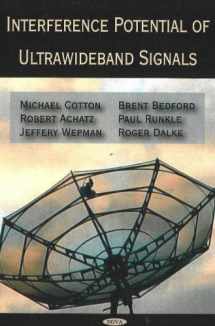
Interference Potential of Ultrawideband Signals
ISBN-13:
9781600213595
ISBN-10:
1600213596
Author:
Michael Cotton, Robert Achatz, Jeffery Wepman, Brent Bedford, Paul Runkle
Publication date:
2007
Publisher:
Nova Science Pub Inc
Format:
Hardcover
319 pages
FREE US shipping
Book details
ISBN-13:
9781600213595
ISBN-10:
1600213596
Author:
Michael Cotton, Robert Achatz, Jeffery Wepman, Brent Bedford, Paul Runkle
Publication date:
2007
Publisher:
Nova Science Pub Inc
Format:
Hardcover
319 pages
Summary
Interference Potential of Ultrawideband Signals (ISBN-13: 9781600213595 and ISBN-10: 1600213596), written by authors
Michael Cotton, Robert Achatz, Jeffery Wepman, Brent Bedford, Paul Runkle, was published by Nova Science Pub Inc in 2007.
With an overall rating of 4.2 stars, it's a notable title among other
books. You can easily purchase or rent Interference Potential of Ultrawideband Signals (Hardcover) from BooksRun,
along with many other new and used
books
and textbooks.
And, if you're looking to sell your copy, our current buyback offer is $0.3.
Description
The purpose of this book is to provide data needed to predict the interference potential of various UWB signals. The results will be useful for regulatory agencies that are currently charged with defining UWB emission limits and corresponding compliance measurement procedures. They will also be useful to the ultrawideband communications industry, which will only thrive if compliance measurement procedures fairly evaluate interference potential of all UWB signals. operating narrow-band receiver and measure susceptibility of the receiver with precisely defined signal quality metrics. Data is then analysed to determine if there are common signal characteristics that predict interference potential. The victim receiver chosen for this interference susceptibility test is C-band satellite digital television (DTV). This receiver demodulates signals transmitted in the 3.7 to 4.2 GHz frequency range, which lies within the band allocated for UWB devices. than use an unpredictable live signal, to generate interference signals with a vector signal generator rather than rely solely on prototype devices, and to perform signal and system characterisation measurements primarily with the vector signal analyser to provide comprehensive data capable of being post-processed in many ways.


We would LOVE it if you could help us and other readers by reviewing the book
Book review

Congratulations! We have received your book review.
{user}
{createdAt}
by {truncated_author}


